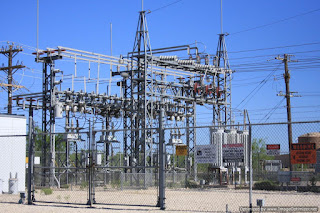Working of Power Station
Most power plants use coal, but some use natural gas, water or even wind. The current is sent through transformers to increase thevoltage to push the power long distances. The electrical charge goes through high-voltage transmission lines that stretch across thecountry.
A power station, also referred to as a power plant or powerhouse and sometimes generating station or generating plant, is an industrial facility for the generation of electric power
We divide the power system into three parts; power generation, transmission and distribution. In this article, we will discuss power generation. Actually, in power generation, one form of energy gets converted into electrical energy. We produce electrical energy from various natural sources. We classify these sources into two types renewable sources and non-renewable sources. In present power system, most of the electrical energy gets generated from non-renewable sources like coal, oil and natural gases. But these sources are limitedly available. So, we have to use these sources carefully and always to find an alternate source or move on renewable sources. The renewable sources include the solar, wind, water, tidal and biomass. These sources are the environment-friendly, free and infinite resource available. Let us get more information about renewable sources.
Electric Capacity in India
Yearly gross electricity generation by source (GWh) (2016-2017)| Source | Generation (GWh) |
| Coal | 944,861 |
| Oil | 275 |
| Gas | 49,094 |
| Diesel | |
| Nuclear | 37,916 |
| Hydro | 122,313 |
| Mini-hydro | 7,673 |
| Solar | 12,086 |
| Wind | 46,011 |
| Biomass | 14,159 |
Most power plants use coal, but some use natural gas, water or even wind. The current is sent through transformers to increase thevoltage to push the power long distances. The electrical charge goes through high-voltage transmission lines that stretch across thecountry.
Its power Station of video in working of Power in Electrical Grand PSCL
Electricity is generated in a power plant. ... The distribution lines carry a lower voltage of electricity than the transmission grid. This conversion of power happens in a power substation. The distribution wires that carry electricity to your house go through another transformer that reduces the voltage even more.
If you like ,keep Subscribe the channel it learn New think
Electric current (electricity) is a flow or movement of electrical charge. The electricitythat is conducted through copper wires in your home consists of moving electrons. The protons and neutrons of the copper atoms do not move. ... The wire is "full" of atoms and free electrons and the electrons move among the atomsYou can see at the back several three-wire towers leaving the substation. Typical voltages for long distance transmission are in the range of 155,000 to 765,000 volts in order to reduce line losses. A typical maximum transmission distance is about 300 miles (483km).it you anytime your information please comment ,and share of knowledge



Stainless Steel Blade - Titanium Blade LLC
ReplyDeleteTitanium blades are forged with titanium dioxide in food high-quality materials that make titanium jewelry them ford escape titanium for sale ideal for corrosion protection. These blades can be made by titanium melting point hand black titanium wedding band for a